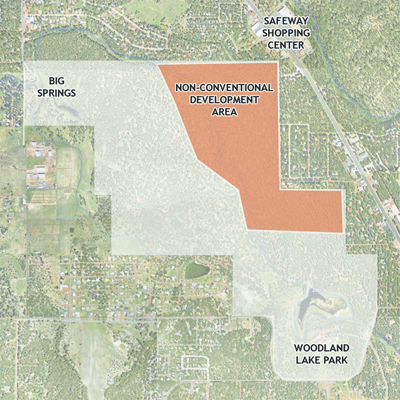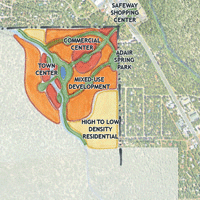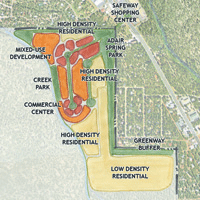Non-conventional development caters to a growing segment of the population that is not satisfied with conventional suburban development (CSD). Non-conventional development is typified by higher density developments where a variety of amenities are within walking distance. Besides the need for more walkable communities other factors leading to preference for non-conventional developments include: mounting traffic congestion, decreased crime, enhanced urban vitality, growth of 'cafe' culture, fashionable design of higher density for middle class, and positive examples by growing densification. Other characteristics of non-conventional development include: creation of town centers, villages with mixed-use infrastructure, compact development, pedestrian oriented communities - this often helps create communities that are designed more at the human scale, focus on the public realm, and the incorporation of parks, greenways, open space, and other environmentally friendly designs and practices. This type of development is concerned with building a high quality community and helping establish a sense of place.
 Often time these projects require a lot more time, energy, and money up front when compared to CSD, but the pay off in all categories far exceeds that of CSD. For the city these projects often require extensive rezoning efforts along with a 'cultural' acceptance of features like smaller lot sizes and narrower street widths. For the developer such projects often require higher up-front costs and more patience than conventional real estate. The financial return often lags a few years behind that of conventional suburban development (CSD). However non-conventional developments have proven themselves more durable. In most cases these are projects constructed with higher quality materials which helps translate into high quality designs. Again there is a concerted effort to create a community and sense of place which are timeless and have unlimited value. And once the community and development are firmly entrenched the financial profits quickly follow. In a recent project in Albuquerque, New Mexico the city invested $14 million dollars into a non-conventional redevelopment project happening in part of its downtown. In return the city will get 25% of the profits that the project earns in years 6-12, and in years 13-20 it will receive 50% of the total profits. While most conventional suburban development is typically based only on the money that it can extract in five to seven years, non-conventional development facilitates increasing profits for all as the years progress. It is not just the developer reaping profit but everyone involved.
Often time these projects require a lot more time, energy, and money up front when compared to CSD, but the pay off in all categories far exceeds that of CSD. For the city these projects often require extensive rezoning efforts along with a 'cultural' acceptance of features like smaller lot sizes and narrower street widths. For the developer such projects often require higher up-front costs and more patience than conventional real estate. The financial return often lags a few years behind that of conventional suburban development (CSD). However non-conventional developments have proven themselves more durable. In most cases these are projects constructed with higher quality materials which helps translate into high quality designs. Again there is a concerted effort to create a community and sense of place which are timeless and have unlimited value. And once the community and development are firmly entrenched the financial profits quickly follow. In a recent project in Albuquerque, New Mexico the city invested $14 million dollars into a non-conventional redevelopment project happening in part of its downtown. In return the city will get 25% of the profits that the project earns in years 6-12, and in years 13-20 it will receive 50% of the total profits. While most conventional suburban development is typically based only on the money that it can extract in five to seven years, non-conventional development facilitates increasing profits for all as the years progress. It is not just the developer reaping profit but everyone involved.
Prior to any non-conventional development project there needs to be extensive market research done and this holds true for the town of Pinetop-Lakeside. Even to seasoned developers who have completed many non-conventional development projects each site has its own characteristics which need to be accounted for prior to building. On the positive side this accounts for the unique and distinct feel that many of these developments exhibit. For additional information about non-conventional developments please read the information provided from the links at the bottom of this page.
- Focus on full-time residents of Pinetop-Lakeside
- Town Center located on Walnut Creek
- High density center transitions to lower density
- Enhanced pedestrian greenway connects Walnut Creek to BIlly Creek
- Development concentrated on east side of Walnut Creek
- Establishes two small commercial centers
- Mixed-use development surrounds commercial cores
- Residential areas with varying densities
To encourage a better understanding of what "mixed-use development" and higher density configurations are, we are providing links to literature about the principles, and an image gallery that depicts some of the principles supported by these scenarios.
- Click here to visit the image gallery.
- Principles of human-scale communities (PDF)
- Finance: Sources, Strategies, and Returns (PDF)
webdesign by chris rose


